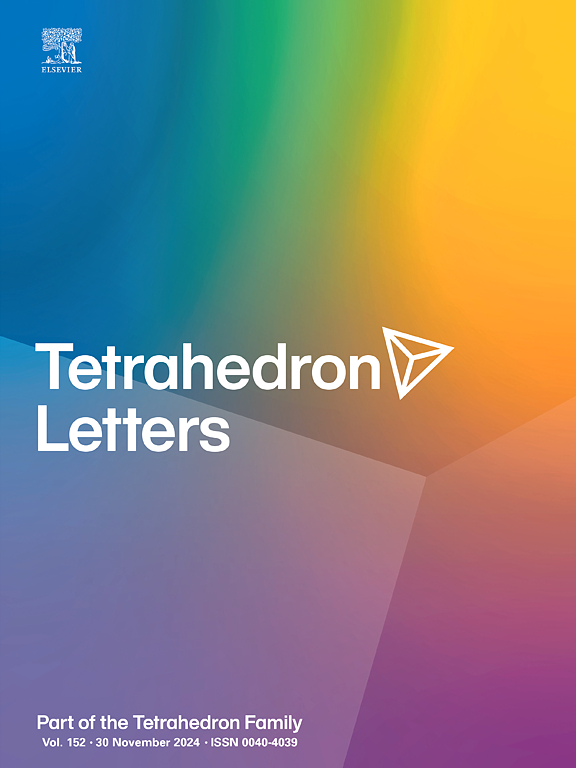Copper(II) NHC pincer complexes containing 1,2,3-triazole units: Synthesis, structure and catalysis for CN bond forming reactions
IF 1.5
4区 化学
Q3 CHEMISTRY, ORGANIC
引用次数: 0
Abstract
Two new tridentate copper(II) N-heterocyclic carbene (NHC) pincer complexes with triazolyl donor groups, L2, [TrzmPymBI][PF6] and L3, [bTrzmBI][PF6], were synthesized and characterized by X-ray single crystal analysis and elemental analysis. The 5-coordinate τ value shows distorted square pyramidal geometry for both complexes. These copper(II)-NHC complexes exhibited excellent catalytic activity (95–100 % conversion) for N![]() H insertion reactions toward the formation of new N
H insertion reactions toward the formation of new N![]() C bonds between aniline and methyl phenyldiazoacetate. Under optimized conditions, the catalyst was screened against 22 different aniline derivatives and achieved high conversion (65–100 %) toward both electron-donating and electron-withdrawing functional groups on the amine substrates, while limiting self-coupling of activated diazo compounds. The substrate scope study revealed that steric hindrance and basicity are key factors influencing reactivity. Secondary and aliphatic amines showed weak reactivity. Moreover, the utility of this catalyst was demonstrated through a gram-scale synthesis of a diarylhydantoin, a class of compound known to act as a COX-2 inhibitor. These results highlight the versatility and efficiency of copper(II)-NHC complexes in facilitating selective carbene insertions and provide a promising approach for the synthesis of valuable nitrogen-containing compounds.
C bonds between aniline and methyl phenyldiazoacetate. Under optimized conditions, the catalyst was screened against 22 different aniline derivatives and achieved high conversion (65–100 %) toward both electron-donating and electron-withdrawing functional groups on the amine substrates, while limiting self-coupling of activated diazo compounds. The substrate scope study revealed that steric hindrance and basicity are key factors influencing reactivity. Secondary and aliphatic amines showed weak reactivity. Moreover, the utility of this catalyst was demonstrated through a gram-scale synthesis of a diarylhydantoin, a class of compound known to act as a COX-2 inhibitor. These results highlight the versatility and efficiency of copper(II)-NHC complexes in facilitating selective carbene insertions and provide a promising approach for the synthesis of valuable nitrogen-containing compounds.

含1,2,3-三唑单位的铜(II) NHC螯合物:合成、结构及CN成键反应的催化作用
合成了两种新的三唑基给基铜(II) n -杂环碳(NHC)螯合物L2, [TrzmPymBI][PF6]和L3, [bTrzmBI][PF6],并用x射线单晶分析和元素分析对其进行了表征。两种配合物的5坐标τ值均显示出扭曲的方锥体几何形状。这些铜(II)-NHC配合物在苯胺和苯基重氮乙酸甲酯之间形成新的NC键的NH插入反应中表现出优异的催化活性(转化率为95 - 100%)。在优化条件下,该催化剂对22种不同的苯胺衍生物进行了筛选,并在胺底物上实现了给电子和吸电子官能团的高转化率(65 - 100%),同时限制了活化重氮化合物的自偶联。底物范围研究表明,位阻和碱度是影响反应性的关键因素。仲胺和脂肪胺反应性较弱。此外,这种催化剂的效用通过克级合成二芳基酰脲(一种已知作为COX-2抑制剂的化合物)得到了证明。这些结果突出了铜(II)-NHC配合物在促进选择性碳插入方面的通用性和效率,为合成有价值的含氮化合物提供了一种有前途的方法。
本文章由计算机程序翻译,如有差异,请以英文原文为准。
求助全文
约1分钟内获得全文
求助全文
来源期刊

Tetrahedron Letters
化学-有机化学
CiteScore
3.50
自引率
5.60%
发文量
521
审稿时长
28 days
期刊介绍:
Tetrahedron Letters provides maximum dissemination of outstanding developments in organic chemistry. The journal is published weekly and covers developments in techniques, structures, methods and conclusions in experimental and theoretical organic chemistry. Rapid publication of timely and significant research results enables researchers from all over the world to transmit quickly their new contributions to large, international audiences.
 求助内容:
求助内容: 应助结果提醒方式:
应助结果提醒方式:


